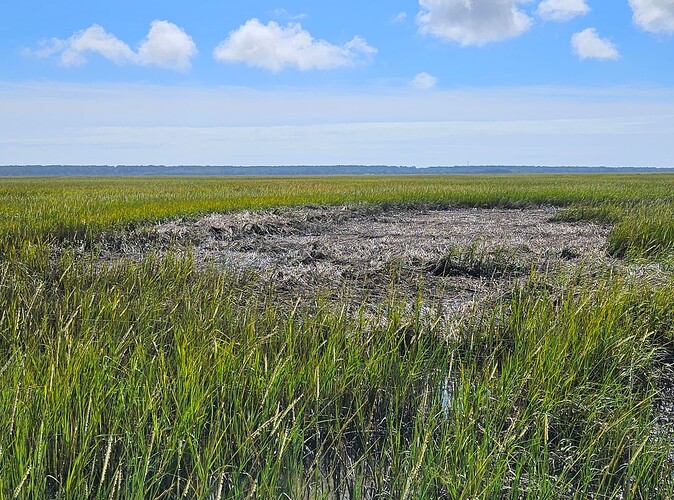Can anyone explain the pockets of flattened seagrass I see intermittently in the marsh.
It’s called a salt pan, in a nutshell it’s where moving sand and erosion cause an indention in the marsh where saltwater gets trapped, then evaporates leaving behind an area not conductive for marsh vegetation to thrive.
It’ll wash out
But anyway, I’ve always heard them refered to as salt pans
Welcome to the site
Interesting. I learned something new today ![]()
I know stuff, a little about a whole lot of stuff, and not a whole lot about any of it, lol
I believe sometimes they are caused by big patches of dead spartina grass that get blown out into the waterway and stack up together on really high tides potentially with the right wind causing an exceptionally high tide.
Once consolidated into a big patch (similar to sangam offshore) it gets pushed into the green grass and get stuck on the falling tide. It settles and bends over/chokes out the live green grass which causes it to settle deeper and become entrenched, killing the grass below.
As that spartina decomposes into detritus to feed the oysters, it slowly drifts away on high tides creating a dead patch of pluff mud.
I have watched the occur in three separate spots in the Bowens Island/Clark Sound area this past summer
I like EFs theory as well though
I have a salt marsh for a back yard. Happy to provide support for Rapchizzle’s theory as one alternative, having seen it happen often when wind direction combined with big tides push dead marsh grass from a big area into a small spot. The grass gets suppressed but fills back in overtime as the old dead grass decomposes or moves away on the next giant tide with wind from a different direction.
Seems most commonly formed in spring when the new grass is not very tall and lots of old grass around. Once the grass around the spot grows above even a really high tide again, hard for the pile of dead grass to get moved by the next high-water event. No idea what that kind of “dead spot” in the marsh is called.
EF1, thankyou for your thoughtful answers. I also chuckled about your knowledge base. In my career, I learned more and more about less and less until I knew everything about nothing…
Have some of those spots in the marsh near me. Like @Rapchizzle, they were caused by 2 big storms last year. Slowly rotting and getting removed by the king tides. Green shoots poking through.
